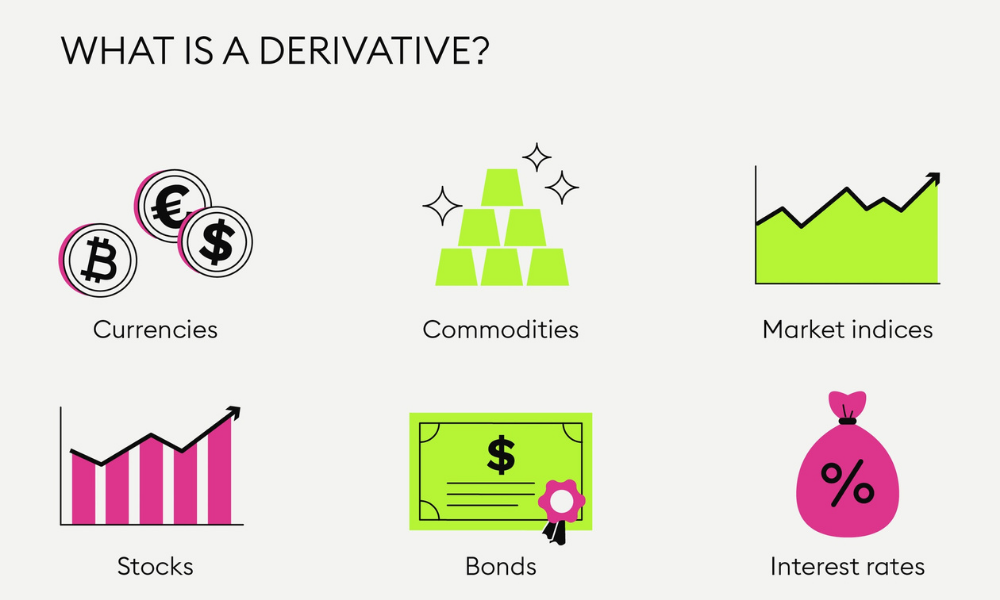Obtaining financial literacy is a complicated process that entails a confident understanding of majo...

Obtaining financial literacy is a complicated process that entails a confident understanding of major financial concepts such as implementing money-saving strategies or creating investing roadmaps.
It starts by acquiring basic knowledge of money matters and proceeds with research on more advanced financial tools. In this article, we will shed some light on the financial phenomenon of derivatives.
Take a seat and enjoy the journey!
What Are Financial Derivatives and How Do They Work?
Derivatives are contracts binding two parties that enter into a commitment to hand over a pre-agreed asset (or a pre-agreed derivative value) at the predetermined time and at the preset price.
There are several types of underlying assets; they can be a financial asset, an index (a set of assets), security, or even an interest rate.
The purchaser agrees to buy the specific asset on the predetermined date at the preset price.
Notably, a derivative’s seller doesn’t have to be the owner of an underlying asset, as they can deliver on the contract by simply providing a purchaser with enough money to buy the agreed-upon asset at the specific price.
Let's see how it works. Consider an American investor, Jeff, whose accounts are denominated in USD. Jeff buys shares of a European company via any of the operating EU exchanges for euros.
From then onward, Jeff is vulnerable to the risk of a shift in the exchange rate. If the value of the US dollar against the euro rises, Jeff won't profit from selling his shares of the European company.
If a seller gives a purchaser another derivative, it will offset the value of the first contract. That’s the main reason why derivative contracts are much easier to manage and trade than any type of underlying asset itself.
Derivatives can serve as effective financial instruments for the purposes of risk mitigation (hedging) or be used to speculate on possible risks for the sake of a commensurate reward.
Derivatives are usually traded on specialized exchanges, with some of them being traded off-exchange or over-the-counter (OTC).
Types And Classes of Derivatives
Derivative products can be separated into two classes: lock products (e.g., swaps) and options products (e.g., stock options). Lock products seal the deal between the corresponding parties from the outset to the negotiated terms during the life of the contract.
Option products provide the holder with the right (without any obligations) to trade the underlying asset at a specific contract price on or before the option expires.
As we have already mentioned above, a derivative’s value is based on an asset; however, if you own a derivative, it doesn’t mean that you own the asset itself. The most common types of derivatives are futures, forwards, options, swaps, and warrants. Let’s learn a bit more about them.
Forwards vs. Futures
A forward, also known as a forward contract, is a customized private contract between two respective parties that is concluded in order to buy or sell an underlying asset at an agreed-upon price on a specific date.
Forwards are frequently used for either hedging or speculation, though their non-uniform nature makes them a perfect tool tailored for hedging.
Forwards and futures have a lot in common, yet they are not perfectly alike. Both are based on the agreement to buy and sell some assets at the preset date, while their prices are derived from corresponding underlying assets.
A future, also known as a futures contract, is a likewise legal
Arrangement to buy or sell some assets at a predetermined price at a preset time in the future.
However, a future is a standardized contract between a party and an exchange market that is characterized by fixed maturity dates and a day of expiration.
So, there is a significant difference between forwards and futures: a forward contract can be customized to a commodity, amount, date, and place of delivery; it always settles at the end of the expiration date and is an OTC derivative.
Warrants
A warrant is a financial derivative that is issued by the company itself, providing its owner with the right (without any obligations) to trade securities — usually equities — at an agreed-upon price before the given expiration date.
Warrants are rarely issued by a third party and are often OTC-traded. The prevailing price of the underlying security is called an exercise price or a strike price, and once a warrant is exercised, an underlying stock must be delivered.
There is a substantial difference between American and European warrants; the first ones can be completed at any moment on or before the expiration date, while the second type of warrant can only be exercised on the preset date of expiration.
Options
An option shares some common traits with a warrant, as it also grants the purchaser the right (without any obligations) to buy or sell the underlying asset at a preset price.
However, options don’t have to be issued by a company; they are typically contracts that are traded between two people without any business entity being involved.
Another distinctive feature of an option contract is that the contracting parties are not required to honor the agreement to purchase or sell the asset.
An option can be defined as “an opportunity,” while a future is always “an obligation.”
Swaps
Swaps are the most widespread and tradable derivatives. A swap is a temporary exchange of assets (currency, securities, stocks, etc.) in trading on an exchange.
The main feature of a swap is that the exchange is transitory; the parties to the transaction will have to return their assets to each other within the stated period of time.
Swaps are used to drive out potential risks and enable investors to access the prevailing markets that operate under different jurisdictions. (Continue reading with LiteFinance)